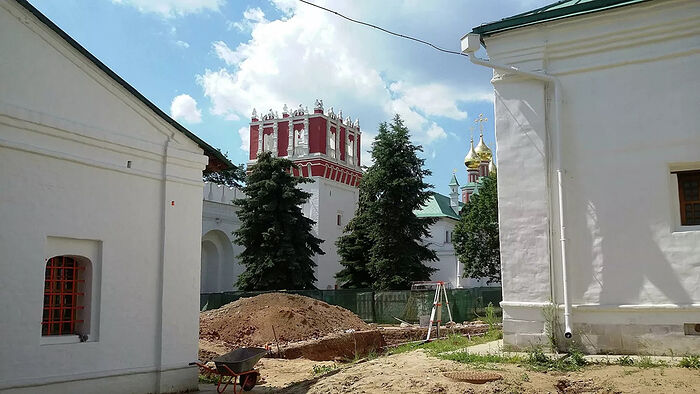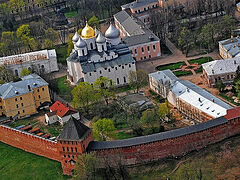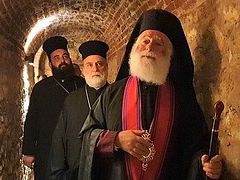Moscow, August 7, 2020
Located picturesquely on the Moscow River south of the city’s center, Novodevichy is one of Moscow’s most famous monasteries. Now archeologists from the Russian Academy of Sciences have uncovered fragments of the original structures which predate the current architectural ensemble. The newly discovered ruins are said to date to the time of Tsar Boris Godunov.
“The fabulous architecture we admire today is the creation of architects and artists of the 1680s and 1690s, when the monastery was rebuilt by the sister of Peter the Great, Tsarevna Sophia. But what was the monastery like for almost two centuries before that? We managed to finally solve this riddle, which had long occupied the thoughts of historians of the monastic life, architecture, and city planning of Moscow,” said the director of the Novodevichy Expedition of the Institute of Archeology of the Russian Academy of Sciences, Leonid Belyaev, according to RIA Novosti.
The Novodevichy Convent was founded on May 13 (26), 1524 by the Grand Duke of Moscow Vasily III in memory of the annexation of Smolensk in 1514. From the first years of the monastery's existence, representatives of the most noble families, including royals and princesses, took the tonsure here: Irina, the sister of Boris Godunov, became a nun there, and in the Smolensk Cathedral, Godunov himself was proclaimed Tsar.
From written sources, it is known that during the reign of Boris Godunov, the murals of the Smolensk Cathedral were renovated. Probably, at the same time, stone walls were erected, which, despite the destruction of the Time of Troubles, stood until the end of the seventeenth century. During the reconstruction of the monastery, Tsarevna Sophia erected new, richly decorated baroque walls with teeth-like merlons and crenellations, towers on which appeared decorations in the shape of crowned tops, and a unique Russian style of machicolations, which appear to be cut down through the wall itself, rather than being built on battlements extended on corbels.
“Historians have at their disposal a schematic representation of the monastery wall from 1611, when it was completely destroyed by the war during the Time of Troubles. Since the 1950s, architects, restorers and archaeologists have tried to find the early walls of the monastery. Alas, the results were zero, and even doubts arose as to their existence,” Belyaev noted.
Recent excavations made it possible to establish that the area of the monastery under Vasily III was much smaller than in modern times. Archaeologists have found traces of a moat that surrounded the monastery, which was one and a half meters deep, and up to three meters wide, and traces of walls about three meters wide. Between the moat and the wall lay a very wide strip—about three meters.
Questions arose about the wall and ditches, and the construction materials: Were the walls made of wood or stone; was the moat and wall built at the same time, or do they belong to different eras?
The answers to these questions were given by a section of the wall discovered just now, made of the same brick as the wall of the huge fortress at Smolensk. “This was a fragment of the tower, which was dismantled during the construction of a new wall during the reign of Tsarevna Sophia, but part of it remained under the rubble of construction debris. The excavation revealed about half of the tower's white stone foundation, into the base of which thick and long wooden stakes were driven; they compacted the soil and structured the masonry until the mortar hardened,” explained the press service of the Institute of Archeology.
The holes preserved in the sandy ground made it possible to reconstruct the tower plan. It turned out that the corner tower of the fence was faceted and rather large: the length of the wide edge exceeded four meters, the width of the tower wall at the base was close to one sazhen (2.16 meters), and the diameter of the circle reached 10-11 meters.
In a layer of turf near the discovered walls, two copper coins were found, minted in the decade of the monetary reform of Tsar Alexei Mikhailovich. They could not have been there before 1654, and most likely were lost while they were in circulation or shortly after the termination of their minting in 1663, it was reported.
Excavations made it possible to understand what the monastery was like before its transformation under Princess Sophia.
"It became obvious that the monastery received a stone wall during the reign of Boris Godunov or a little earlier, during the reign of Tsar Fyodor. The monastery later expanded, and the current walls of the era of Tsarevna Sophia were entirely new and were built from scratch.
The new walls stand outside the perimeter of the sixteenth century monastery, and in some places, they even occupied the edge of the cemetery. The moat along the perimeter of the monastery bypassed the tower, and, therefore, also belonged to Godunov's time. On the other hand, the wide wall inside the moat may mark the line of the earliest wall—the monastery of the era of Vasily III.
According to Leonid Belyaev, although much remains unclear in the history of the early walls of Novodevichy Convent, the archaeological expedition has already “made a number of discoveries that have largely changed our understanding of the culture of Tsarist Moscow in the sixteenth and seventeenth centuries.”
“They allow you to take a fresh look at the role of the monastery in the events of the Time of Troubles, and add one more item to the list of large stone works erected during the reign of Boris Godunov,” the scientist concluded.





